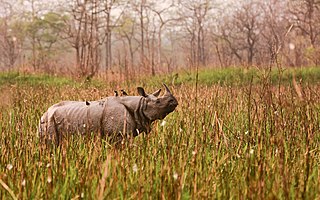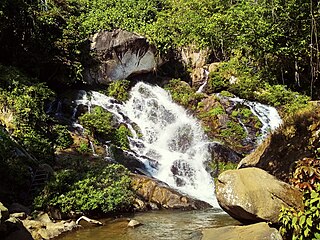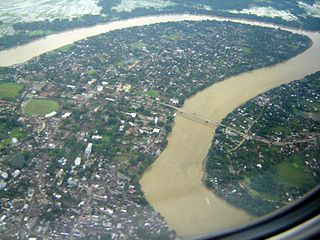The Department of Environment and Forests, Government of Assam is a department under the Government of Assam. [1] [2] [3]
The Department of Environment and Forests, Government of Assam is a department under the Government of Assam. [1] [2] [3]

Assam is a state in northeastern India, south of the eastern Himalayas along the Brahmaputra and Barak River valleys. Assam covers an area of 78,438 km2 (30,285 sq mi). The state is bordered by Bhutan and Arunachal Pradesh to the north; Nagaland and Manipur to the east; Meghalaya, Tripura, Mizoram and Bangladesh to the south; and West Bengal to the west via the Siliguri Corridor, a 22 kilometres (14 mi) wide strip of land that connects the state to the rest of India. Assamese and Boro are the official languages of Assam, while Bengali is an additional official language in the Barak Valley.

Kaziranga National Park is a national park in the Golaghat and Nagaon districts of the state of Assam, India. The park, which hosts two-thirds of the world's great one-horned rhinoceroses, is a World Heritage Site. According to the census held in March 2018 which was jointly conducted by the Forest Department of the Government of Assam and some recognized wildlife NGOs, the rhino population in Kaziranga National Park is 2,613. It comprises 1,641 adult rhinos ; 387 sub-adults ; and 385 calves.

Karbi Anglong district is one of the 34 administrative districts of Assam in India. Diphu is the administrative headquarter of the district. The district is administered by Karbi Anglong Autonomous Council according to the Sixth Schedule of the Constitution of India.

The Indian Forest Service (IFS) is one of the three All India Services of the Government of India. The other two All India Services being the Indian Administrative Service and the Indian Police Service. It was constituted in the year 1966 under the All India Services Act, 1951, by the Government of India.

The flora of India is one of the richest in the world due to the wide range of climate, topology and habitat in the country. There are estimated to be over 18,000 species of flowering plants in India, which constitute some 6-7 percent of the total plant species in the world. India is home to more than 50,000 species of plants, including a variety of endemics. The use of plants as a source of medicines has been an integral part of life in India from the earliest times. There are more than 3000 Indian plant species officially documented as possessing into eight main floristic regions : Western Himalayas, Eastern Himalayas, Assam, Indus plain, Ganges plain, the Deccan, Malabar and the Andaman Islands.

Bongaigaon is a major city in the Indian state of Assam. Its urban area spans across Bongaigaon and Chirang district. The city also serves as the gateway of the North-East Frontier Railway Zone with its New Bongaigaon Junction railway station, the second biggest railway station in North-East India. It also acts as the district headquarters of Bongaigaon district and commercial and industrial hub of the west part of the state of Assam. Bongaigaon is one of the most populated urban agglomerations in Assam, alongside Guwahati, Jorhat, Dibrugarh and Silchar.

Golaghat one of the largest subdivisions of the Indian state of Assam, later elevated to the position of a full–fledged district headquarter on 5 October 1987, is a city and a municipality and the seat of administrative operations of Golaghat district, besides being a twin city to Jorhat which is about 55 km away. It is one of the oldest urban areas in Assam that recently featured on the Smart Cities nominations list, along with Guwahati and four other prominent urban areas of the state; although losing out to Guwahati at the final stage. The Dhansiri, one of the tributaries of the Brahmaputra, passes through Golaghat and is the primary water source for its citizens.

Jorhat is an administrative district of the Indian state of Assam situated in the central part of the Brahmaputra Valley. The district is bounded by Majuli on north, Nagaland state on the south, Charaideo on the east and Golaghat on the west. On the north of the district, the river Brahmaputra forms the largest riverine island of the world. The administrative seat is at Jorhat city.

The Barak River flows 900 kilometres (560 mi) through the states of Manipur, Nagaland, Mizoram and Assam in India. Further it enters Bangladesh where it bifurcates into the Surma river and the Kushiyara river which converges again to become the Meghna river before forming the Ganges Delta with the Ganga and the Brahmaputra rivers and flowing into the Bay of Bengal. Of its length 524 km (326 mi) is in India, 31 km (19 mi) on the Indo–Bangladesh border and the rest is in Bangladesh. The upper part of its navigable part is in India — 121 km (75 mi) between Lakhipur and Bhanga, declared as National Waterway 6, (NW-6) since the year 2016. It drains a basin of 52,000 km2 (20,000 sq mi), of which 41,723 km2 (16,109 sq mi) lies in India, 1.38% (rounded) of the country. The water and banks host or are visited by a wide variety of flora and fauna.
The Ministry of Environment, Forest and Climate Change (MoEFCC) is an Indian government ministry. This ministry is headed by Secretary Rank senior most IAS officer. The ministry portfolio is currently held by Bhupender Yadav, Union Minister of Environment, Forest and Climate Change.
Project Elephant was launched in 1992 by the Government of India Ministry of Environment and Forests to provide financial and technical support to wildlife management efforts by states for their free-ranging populations of wild Asian Elephants. The project aims to ensure the long-term survival of the population of elephants in their natural habitats by protecting them, their habitats and migration corridors. Other goals of Project Elephant are supporting the research of the ecology and management of elephants, creating awareness of conservation among local people, providing improved veterinary care for captive elephants.

The environment of India comprises some of the world's most biodiverse ecozones. The Deccan Traps, Gangetic Plains and the Himalayas are the major geographical features. The country faces different forms of pollution as its major environmental issue and is more vulnerable to the effects of climate change being a developing nation. India has laws protecting the environment and is one of the countries that signed the Convention on Biological Diversity (CBD) treaty. The Ministry of Environment, Forest and Climate Change and each particular state forest departments plan and implement environmental policies throughout the country.

Balmiki Prasad Singh was the 14th Governor of Sikkim, India. He is a retired IAS officer and has written books and articles relating to Indian culture, in particular the culture of North-East India. Among his prominent books are Bahudha and the post 9/11 World and The problem of change: a study of North East India.

Aaranyak is a leading wildlife NGO based in Guwahati. It was founded by Bibhab Kumar Talukdar. It is a Scientific, Industrial Research and frontline environmental organization of India. It works all over the eastern Himalayan region on nature conservation, natural resources management, climate change, disaster management and livelihood enhancement of marginalized communities through research, education and advocacy.

The Jatayu and Sparrow Conservation Breeding Centre (JCBC), is the world's largest facility for the breeding and conservation of Indian vultures (गिध) and the house sparrow. It is located within the Bir Shikargah Wildlife Sanctuary in the town of Pinjore in the State of Haryana, India. It is run by the Haryana Forests Department and Bombay Natural History Society with the help of British nature conservation charity Royal Society for the Protection of Birds. It is 8 kilometres (5.0 mi) from Pinjore and covers 5 acres (2.0 ha).
BARAIL Wildlife Sanctuary is located in the southern part of Assam, India, in Cachar district and lies between 24°55΄53΄΄-25°05΄52΄΄ N latitude and 92°27΄40΄΄-93°04΄30΄΄ E longitude. The Dima Hasao part of Barail is not part of this sanctuary. The altitude ranges between 55–1500 m above mean sea level. It spreads over 326.24 km2. The annual average rainfall and temperature range from 2500–4000 mm and 9.2 °C to 36.2 °C respectively; the Humidity varies from 62% to 83%. Field works in Barail area proposed as a national park/sanctuary in 1980s.

Arunachal Pradesh is land of peanuts in the foothills of the Himalayas in northeast India. It is spread over an area of 83,743 km2 (32,333 sq mi). 98% of the geographical area is land out of which 80% is forest cover; 2% is water. River systems in the region, including those from the higher Himalayas and Patkoi and Arakan Ranges, eventually drain into the Brahmaputra River.
In India, the Head of Forest Forces (HoFF) is the highest ranking Indian Forest Service (IFS) officer in Indian States and Union Territories. All Head of Forest Forces are IFS officers. The HoFF is usually the head of the forest department in every Indian state and is selected by the Governor, based on the recommendation of the council of ministers led by the Chief Minister, from among the senior most Principal Chief Conservators of Forests in the state. The post of HoFF is equivalent in rank, in states, to that of the State Police Chief for the Indian Police Service, chief secretary and lieutenant general of army.

The Chief Secretary is the top-most executive official and senior-most civil servant of the state government. The Chief Secretary is the ex-officio head of the state Civil Services Board, the State Secretariat, the state cadre Indian Administrative Service and all civil services under the rules of business of the state government. The Chief Secretary acts as the principal advisor to the chief minister on all matters of state administration.